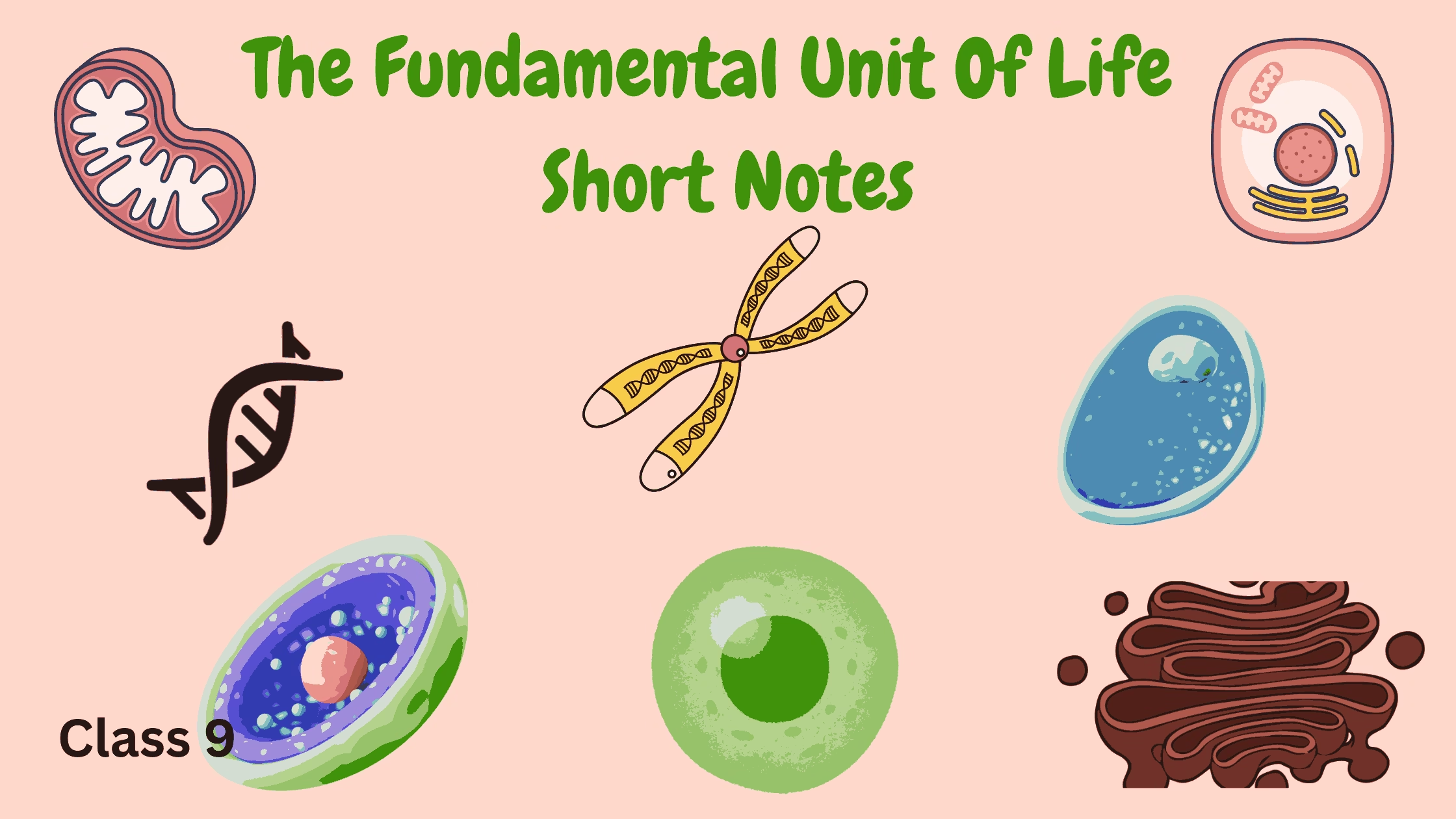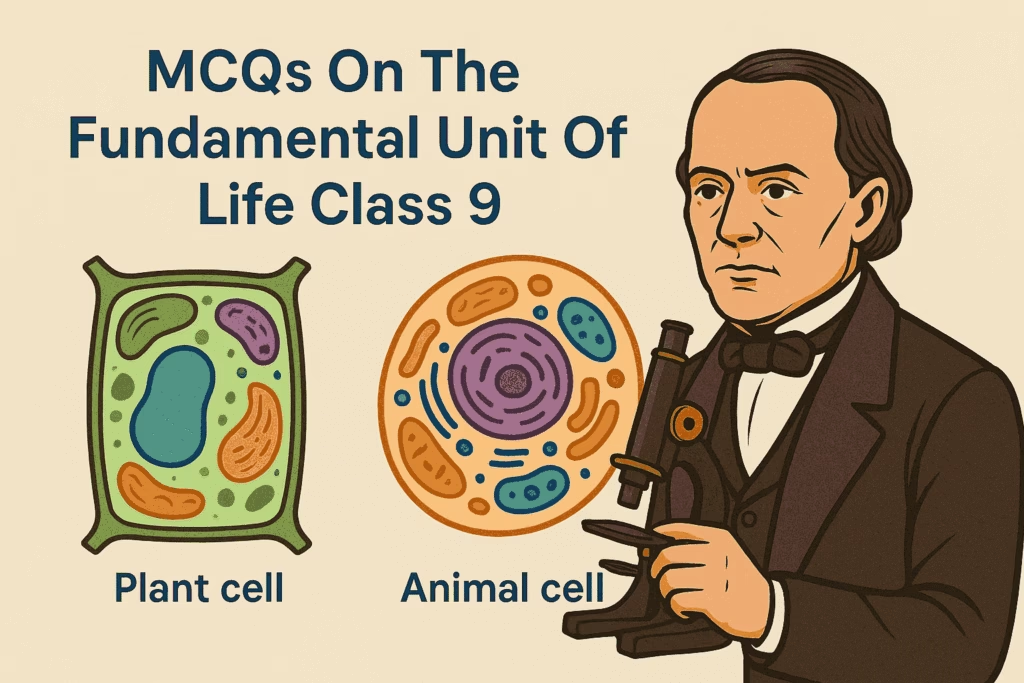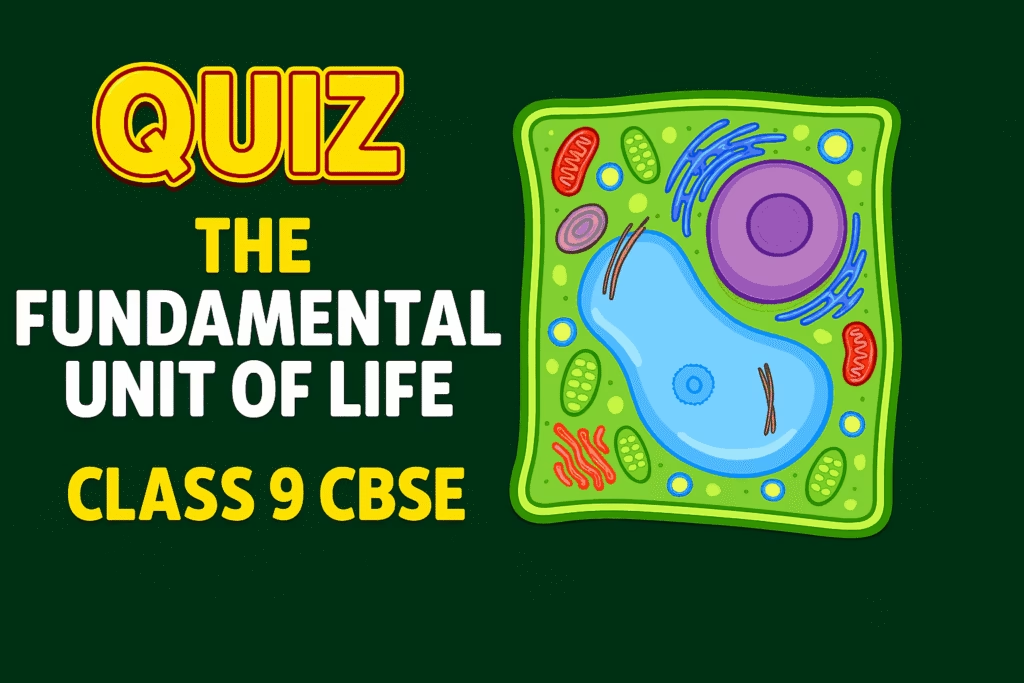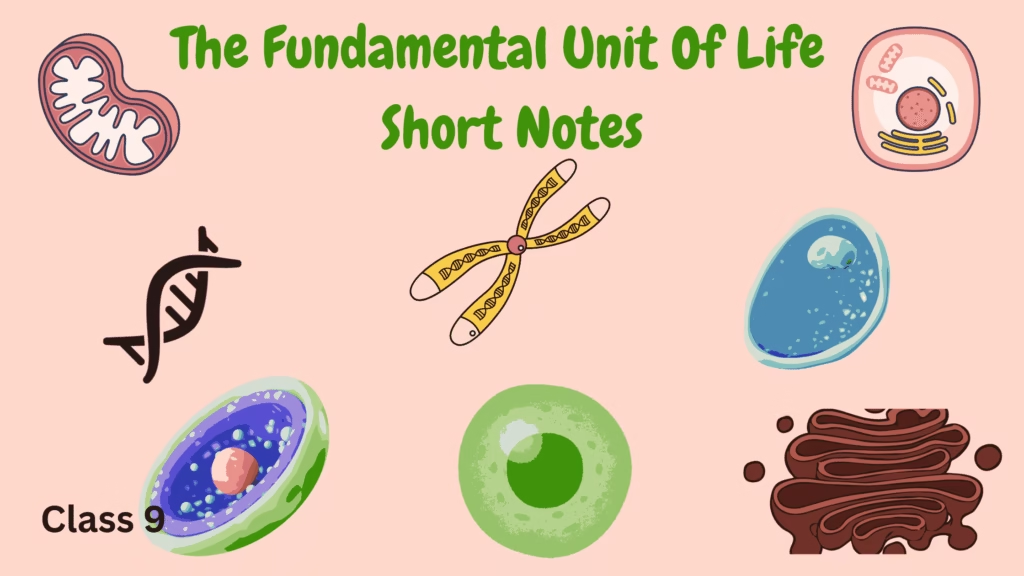
Discovery Of Cell
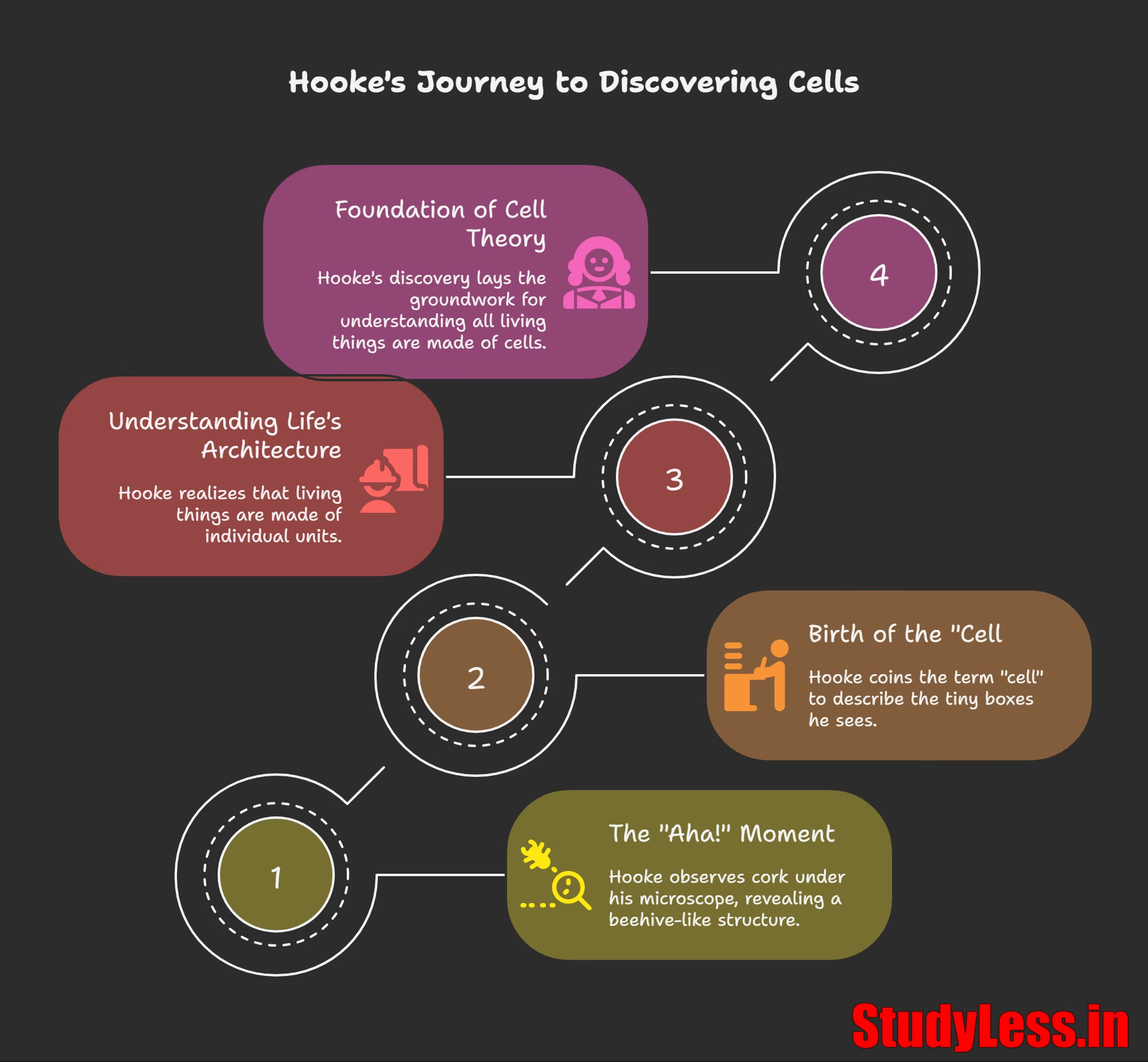
Imagine stepping into a time machine set for London, 1665. No electricity, no smartphones, no modern labs. Just candlelight, quill pens… and a man named Robert Hooke, hunched over his hand-crafted microscope, examining a piece of cork.
Why cork? (Hold this piece of bark in your mind!)
Cork comes from tree bark. It’s light, floats, seals wine bottles. But to Hooke, it wasn’t just bark—it was a mystery waiting to be solved.
Here’s how the magic unfolded:
- The “Aha!” Moment:
Hooke sliced the cork razor-thin. Peering through his microscope lens (which he built himself!), he saw something utterly unexpected. Instead of a smooth surface, it looked like…
👉 A BEEHIVE! 👈
Thousands upon thousands of tiny, empty boxes, neatly packed together like a honeycomb. - The Birth of the “Cell”:
Stunned, Hooke thought, “These little boxes look like tiny rooms… like the cells where monks live!”
“Cell” is Latin for “small room”. That’s the word he used.
And guess what? We still use that exact word 350+ years later! That’s how monumental this was.
But wait… why is this SO important?
(This is where it gets REALLY exciting)
- Before Hooke: People thought living things were just… blobs. Homogeneous goo. No internal structure.
- After Hooke: He was the FIRST person ever to see that living things (even dead cork from a tree) are built from individual, separate UNITS.
- He revealed the hidden architecture of life: Like discovering that a huge castle is made of tiny, identical bricks!
Think of it this way:
🔍 Hooke didn’t just see cork.
🔍 He saw the blueprint of LIFE ITSELF!
The Bigger Picture:
- DIY Science Hero: Hooke built his OWN microscope! Imagine grinding lenses by hand in candlelight. Pure dedication!
- A Lucky Glimpse: It was a “chance observation.” Science often starts by accident… but you need a genius like Hooke to notice its significance!
- The Foundation Stone: Hooke’s “cells” were dead plant walls. He didn’t see the living stuff inside (that came later). BUT he kicked open the door! His discovery started the quest to understand that ALL living things—plants, animals, YOU—are made of CELLS!
So, next time you look at ANYTHING alive…
…a leaf, your pet, your own hand… remember Robert Hooke in 1665, staring slack-jawed at a slice of cork, realizing:
“Life isn’t a solid mass. It’s a magnificent mosaic… built cell by cell by cell!”
Ready to explore what’s INSIDE those cells? 😉 What secrets do YOU think they hold?
What are Living Organisms Made Up of?
Let’s dive into the microscopic universe inside every living thing with the same energy and wonder. Picture this as a detective story spanning centuries…
🔬 The GREAT CELL DETECTIVES: A 300-Year Mystery Unfolds! 🔍
Imagine you’re holding an onion. You peel it, you cry (thanks, sulfuric compounds!). But under a microscope? 🔥 MAGIC! You see this:
👉 Thousands of tiny “building blocks” – like bricks stacked together.
These are CELLS!
But here’s the shocker: You’re built of these too! So is your dog, that ant on the floor, even the mold on bread.
⏳ TIMELINE OF EUREKA MOMENTS: Meet the Cell Squad!
| Year | Scientist | Breakthrough | Why It’s EPIC |
|---|---|---|---|
| 1665 | Robert Hooke | Saw dead “boxes” in cork under his DIY microscope. Called them “cells” (tiny rooms). | FIRST person to see cells! (Even if they were dead plant walls). |
| 1674 | Anton van Leeuwenhoek | Upgraded microscope → saw LIVING cells in pond water! (“Animalcules”) | Discovered a SECRET MICROBIAL UNIVERSE! Bacteria, sperm, blood cells – alive! |
| 1831 | Robert Brown | Spotted a dark blob inside plant cells → named it the NUCLEUS (“kernel”). | Found the CELL’S CONTROL CENTER! (Like discovering the brain in a tiny robot!). |
| 1838-39 | Schleiden & Schwann | Studied plants & animals → shouted: “ALL LIVING THINGS ARE MADE OF CELLS!” | BIRTH OF THE CELL THEORY! Biology changed forever! 🎉 |
| 1855 | Rudolf Virchow | Declared: “OMNIS CELLULA E CELLULA!” (All cells come from PRE-EXISTING CELLS!) | Killed “spontaneous generation” myth! Life ONLY comes from life! 🔥 |
| 1940 | Electron Microscope | Zoomed in 1,000,000x → revealed MITOCHONDRIA, ER, RIBOSOMES! | Saw the TINY ORGANS (organelles) that keep cells alive! Like finding engines in LEGO bricks! |
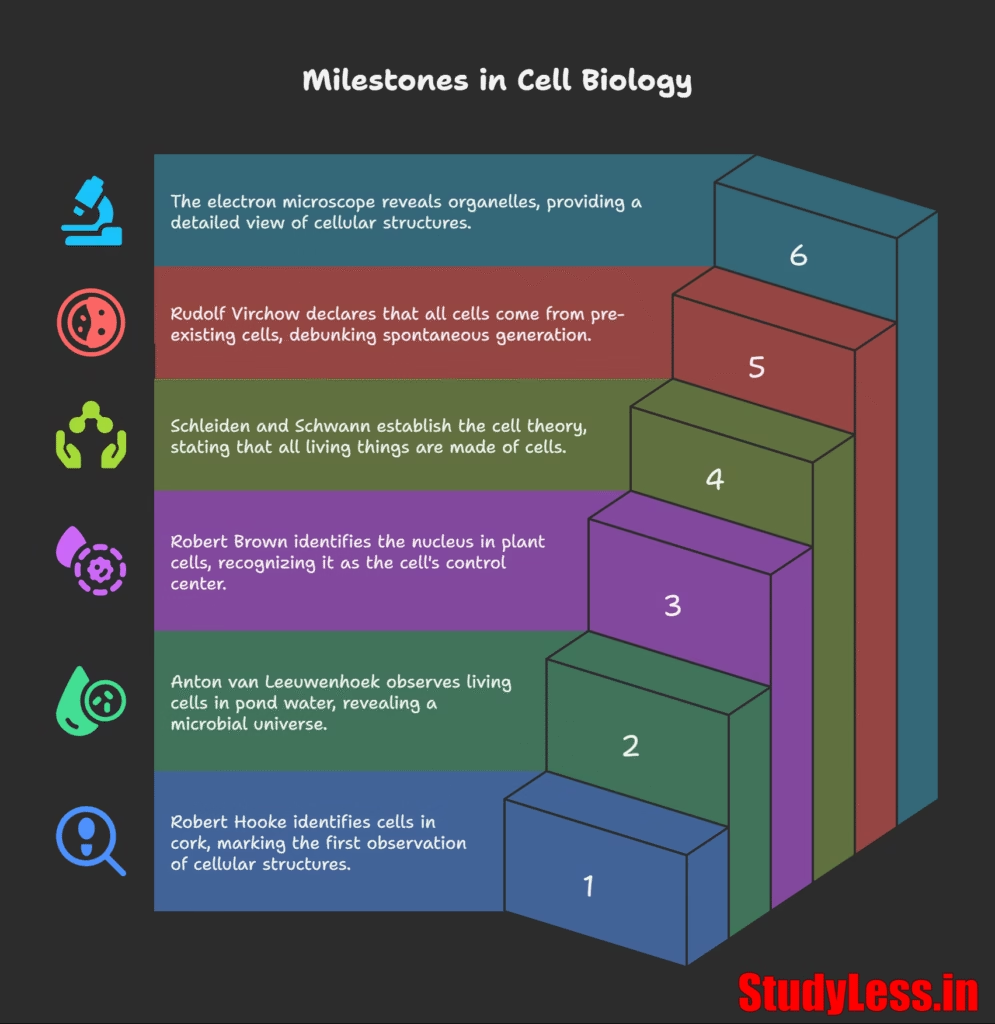
🧩 WHY are CELLS the “Structural & Functional Unit of Life”? (The BIG Answer!)
- STRUCTURAL UNIT? → They’re LIFE’S LEGO BRICKS!
- 🌰 Onion? Stacked plant cells.
🐘 Elephant? Trillions of animal cells.
🦠 Amoeba? ONE CELL = ENTIRE ORGANISM! (Shapeshifting superhero!).
→ Every living thing, big or small, is built from cells.
- FUNCTIONAL UNIT? → They’re TINY INDEPENDENT FACTORIES!
- Inside EVERY CELL:
- “Organelles” = Tiny machines doing specialized jobs!
🔋 Mitochondria = POWER PLANTS
🧬 Nucleus = DNA BLUEPRINT LIBRARY
🚚 Golgi = PACKAGING & SHIPPING DEPOT - Division of Labor: Like a city where every organelle has a role!
- “Organelles” = Tiny machines doing specialized jobs!
- A SINGLE CELL can:
- Eat, Breathe, Grow, Respond, Reproduce → ALL LIFE ACTIVITIES!
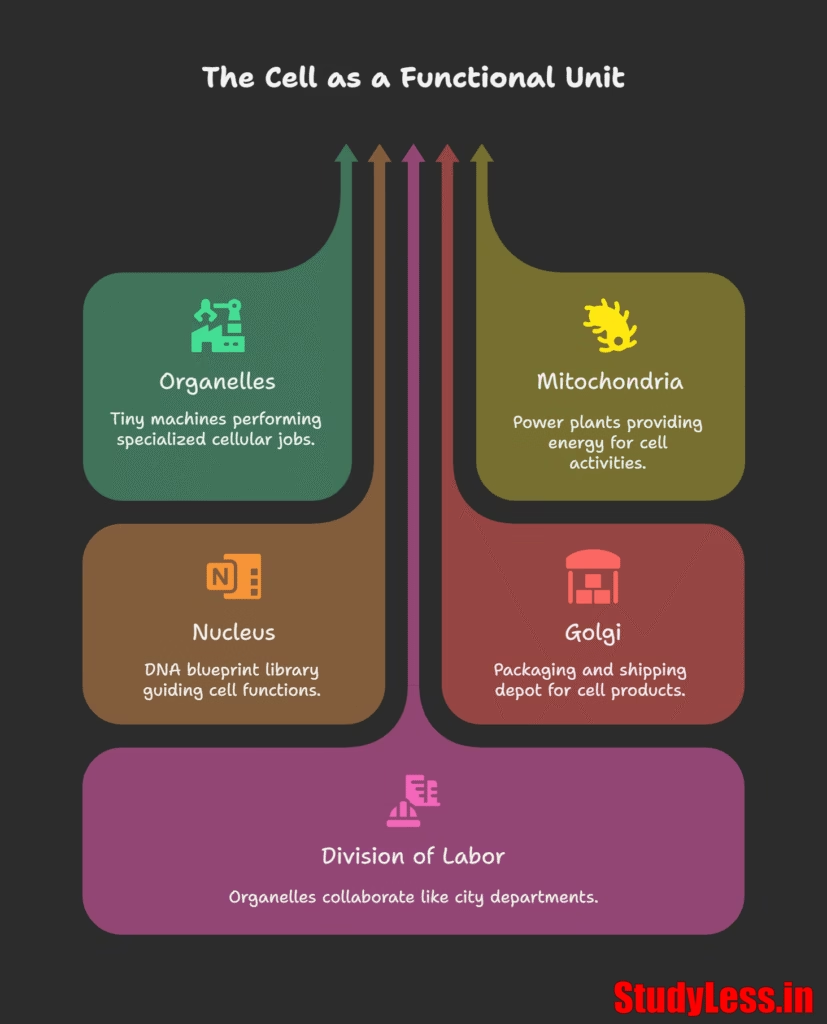
🤯 MIND-BLOWING REALITY CHECK:
You are a walking, talking CITY OF 30 TRILLION CELLS.
Each one has:
- Its own power stations (mitochondria)
- Its own blueprint room (nucleus)
- Its own recycling crew (lysosomes)
…all working in harmony to make YOU alive right now.
🧠 QUESTIONS:
- Who discovered cells, and how?
👉 Robert Hooke in 1665! He saw dead, box-like “cells” in cork using a homemade microscope.
- Why is the cell the structural and functional unit of life?
👉 STRUCTURAL: ALL living things (onions, humans, bacteria) are built of cells → they’re life’s “building blocks”.
👉 FUNCTIONAL: EVERY cell can perform ALL life processes (eat, grow, reproduce) using its tiny “organelles” → they’re life’s “tiny independent factories”!
Ready to zoom INSIDE a cell?
🚀 What tiny organelle do YOU want to explore first? (Mitochondria? DNA-packed nucleus? The cell’s “stomach”? Let’s go!)
What is a Cell Made Up of ?
What is the Structural Organization Of A Cell?
Buckle up! 🔬 We’re about to dive INSIDE a living cell – and it’s even more mind-blowing than Hooke’s cork boxes! Imagine peeling back the roof of a microscopic city…
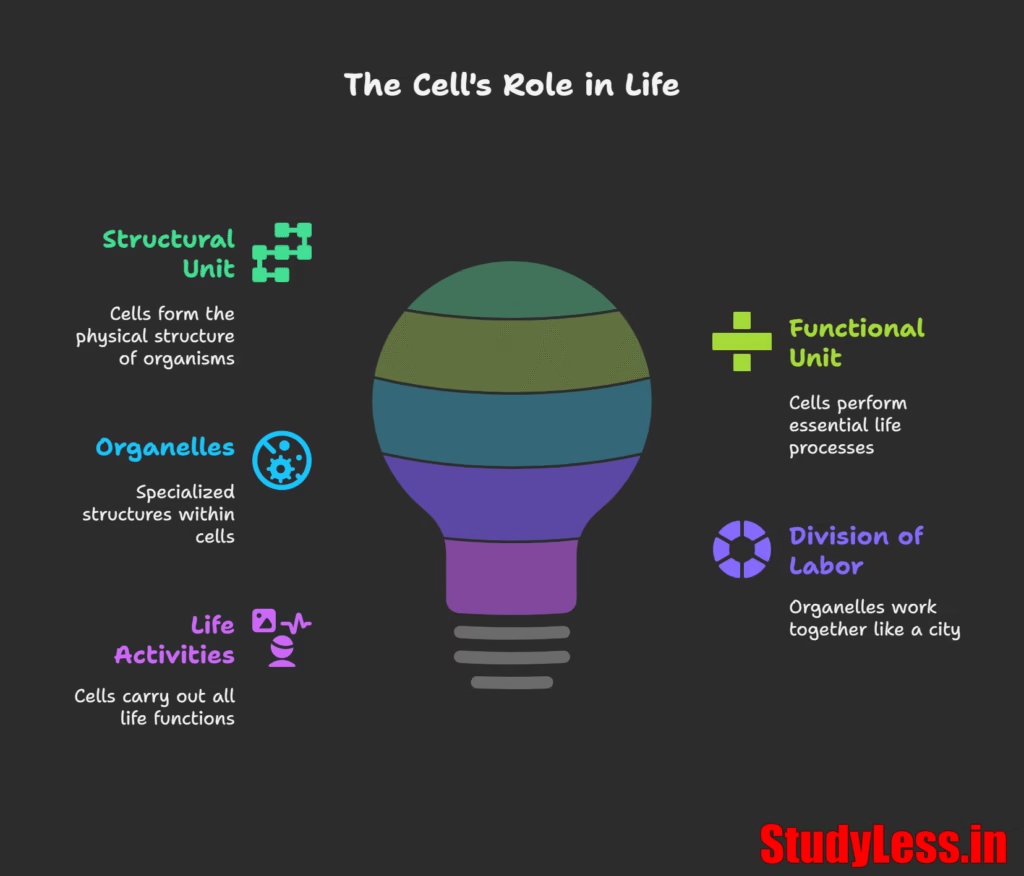
Every single cell on Earth (plant, animal, bacteria, YOU) shares 3 CRITICAL COMPONENTS:
(Think of them as the cell’s “Holy Trinity”)
| Component | What It Is | Why It’s VITAL |
|---|---|---|
| 1. Plasma Membrane (Cell Membrane) | The “City Wall + Security Gate” 🛡️ (A thin, flexible barrier made of fats & proteins) | Controls EVERYTHING in/out! Food? Oxygen? Waste? Signals? IT DECIDES. Keeps the cell’s “identity”. |
| 2. Cytoplasm | The “City’s Jelly-filled Streets” 🌆 (A thick, gel-like fluid filling the cell) | Where LIFE HAPPENS! Organelles float here. Chemical reactions buzz like traffic. Transports materials. |
| 3. Nucleus | The “Mayor’s Office + Central Library” 📚🔒 (A large, membrane-bound organelle) | Holds the CELL’S DNA (blueprints!) Controls growth, reproduction, identity. “Command Center!” |
🔥 KEY TRUTH:
It’s NOT just “stuff” floating randomly! Organization is EVERYTHING. These 3 parts work together like a perfectly designed micro-city!

🏙️ STRUCTURAL ORGANISATION: How the Cell City Works!
Imagine a bustling metropolis inside a water balloon! Here’s how it’s organized:
- THE BOUNDARY: Plasma Membrane (The “Smart Wall”)
- Made of phospholipids → fatty molecules that form a DOUBLE LAYER (like a sandwich!).
- Studded with PROTEINS that act as:
→ Gatekeepers (channels & pumps).
→ Security Guards (receptors for signals).
→ ID Cards (markers saying “This cell is ME!”). - It’s SELECTIVELY PERMEABLE! Like a bouncer with a list – only lets in water, oxygen, food, etc. Blocks toxins/waste.
- THE CITY GROUNDS: Cytoplasm (The “Living Jelly”)
- Not just water! Packed with salts, nutrients, enzymes, and ORGANELLES (tiny “organ-machines”).
- The Cytoskeleton: An invisible NETWORK OF PROTEIN FIBERS 🕸️ crisscrossing the cytoplasm. It’s the city’s:
→ Roads & Bridges (transport tracks).
→ Scaffolding (gives the cell SHAPE).
→ Muscles (allows movement!).
- THE CONTROL CENTER: Nucleus (The “Fortress of Secrets”)
- Surrounded by the NUCLEAR ENVELOPE (a double membrane wall with PORES for controlled access).
- Contains CHROMATIN (DNA + proteins) – the MASTER BLUEPRINT for building everything!
- Houses the NUCLEOLUS – a dense spot making RIBOSOMES (protein factories!).
Plasma Membrane Or Cell Membrane
Brace yourself—we’re entering the MOLECULAR GRAND CENTRAL STATION of your cells! 🚉
The plasma membrane isn’t just a “wall”—it’s a living, breathing border control with rules, gates, and emergency protocols. Let’s break it down:
🔑 THE CORE MYSTERY: How Do Molecules Cross?
(Imagine tiny molecules queuing at a nightclub door…)
| Substance | How It Moves | Real-Life Example | Why It Matters |
|---|---|---|---|
| CO₂ / O₂ | DIFFUSION 🌀 | CO₂ rushes OUT of muscle cells (high → low concentration) | Lets cells breathe! No energy needed—just physics! |
| WATER | OSMOSIS 💧 | Roots suck up water from soil (low solute → high solute) | Keeps cells hydrated or stops them from exploding! ⚠️ |
| GLUCOSE | ACTIVE TRANSPORT ⚡ | Gut cells pump glucose INTO blood (against concentration gradient!) | Requires ENERGY (ATP). Like a bouncer dragging VIPs inside! |

🌊 OSMOSIS: The Great Water Heist
What happens to cells in different solutions? (Visualize this!)
| Solution Type | Animal Cell (e.g., RBC) 🩸 | Plant Cell (e.g., onion) 🌱 | Why? |
|---|---|---|---|
| HYPOTONIC (Dilute) | SWELLS & BURSTS 💥 (Lysis) | Becomes TURGID (stiff) ✅ | Water floods IN → plants STAND UPRIGHT! |
| ISOTONIC (Balanced) | Stays NORMAL 🟢 | Stays NORMAL 🟢 | Water in = Water out → IV fluids use this! |
| HYPERTONIC (Concentrated) | SHRIVELS 🥀 (Crenation) | SHRIVELS (PLASMOLYSIS) 🥀 | Water escapes → pickles are hypertonic (cucumbers shrink in salt!) |
💡 Key Insight: Osmosis isn’t just diffusion—it’s water’s desperate sprint to balance solute concentrations!

🧩 STRUCTURE SECRETS: Why Is It “Selectively Permeable”?
The membrane is a FLUID MOSAIC:
- Lipid Bilayer: Two layers of phospholipids (heads love water, tails hide from it → spontaneous barrier!).
- Protein Gates: Channels (tunnels for ions), carriers (shuttle glucose), receptors (signal antennas).
- Sugar ID Tags: Glycoproteins shout “I’m a liver cell, not bacteria!” 🆔
→ It’s “selective” because:
- Passive Transport: Small/nonpolar molecules (O₂, CO₂) slip through freely.
- Active Transport: Polar/charged molecules (glucose, ions) need protein doormen + energy.
🧪 ENDOCYTOSIS: The Cell’s “Pac-Man Mode”
When a molecule is TOO BIG to use a gate (like a burger 🍔):
- Membrane folds inward (like arms hugging food).
- Forms a vesicle (food-filled bubble).
- Amoebas eat bacteria this way! Your immune cells do too.

Cell Wall
Imagine we’re floating down a quiet river together—the water whispering secrets about life itself. Suddenly, we drift past a towering oak tree on the bank, and you ask:
“How do plants stand so tall against storms, while animal cells burst so easily?”
🌊 Let the river answer…
🌿 THE PLANT CELL’S SECRET ARMOR: THE CELL WALL
(Not just a wall—a living, breathing fortress!)
You: “But wait—don’t all cells have a plasma membrane?”
Me: “Yes! But plants? They’ve built a SECOND LAYER OF DEFENSE outside it—the cell wall.”
| Feature | Animal Cell 🦒 | Plant Cell 🌻 | Why It Matters |
|---|---|---|---|
| Outer Layer | Only plasma membrane | Plasma membrane + RIGID CELL WALL | Walls let plants grow sky-high without collapsing! |
| Made Of | ❌ | CELLULOSE (Nature’s steel beams!) | Complex sugar chains woven like a basket—strong yet flexible. |
| Superpower | Bursts in water 💥 | Swells but NEVER bursts 🛡️ | Holds back osmotic pressure like a dam! |
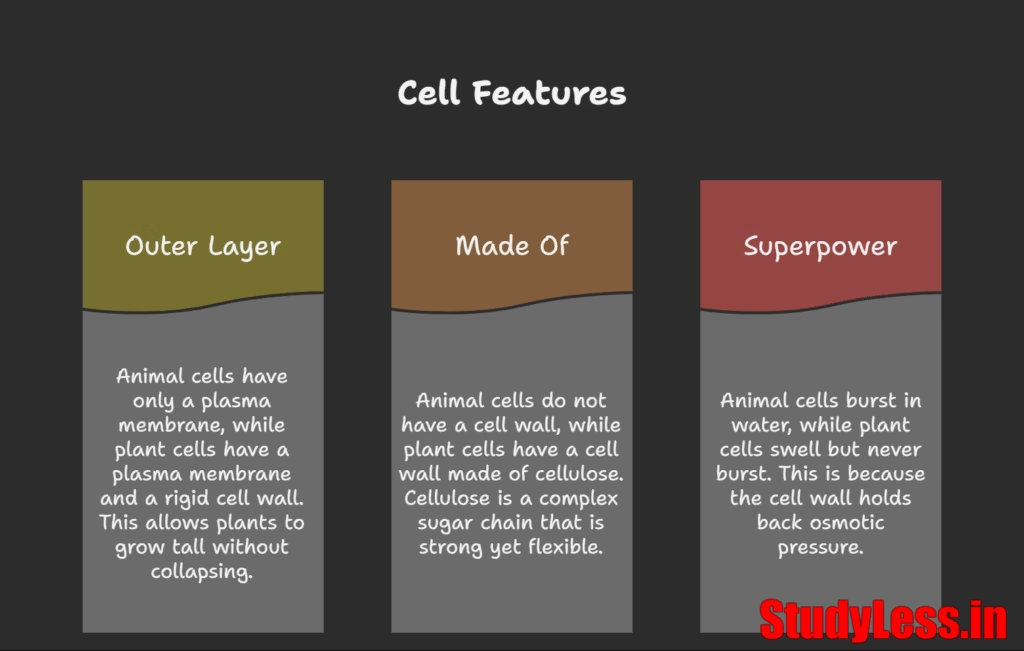
🚰 OSMOSIS STRIKES AGAIN: What Happens When Drought Comes?
(The river dries… the plant thirsts…)
You: “If plant cells love water so much, what happens when they lose it?”
Me: “Watch closely—it’s called PLASMOLYSIS, and it’s tragic…”
- Sun bakes the soil → Water outside vanishes.
- The cell’s environment turns HYPERTONIC (too salty!).
- Water rushes out through the plasma membrane (osmosis!).
- The cell SHRINKS AWAY from its wall like a raisin peeling from its skin.
→ This is plasmolysis: the moment life recoils from its fortress.
💔 Only LIVING cells do this. Dead cells don’t care.

🌳 WHY TREES DON’T COLLAPSE (But Your Blood Cells Would)
(Nature’s genius trade-off)
| Scenario | Animal Cell 🩸 | Plant Cell 🍃 |
|---|---|---|
| Dropped in a lake | Swells → BURSTS (Lysis) 💥 | Swells → BECOMES TURGID (stiff!) ✅ |
| Thrown in salt | Shrivels → DIES (Crenation) 🥀 | Shrivels → PLASMOLYSIS (but survives!) 🌵 |
Why?
👉 The cell wall holds plants together against floods.
👉 When drought hits, plasmolysis protects them—waiting for rain to return!
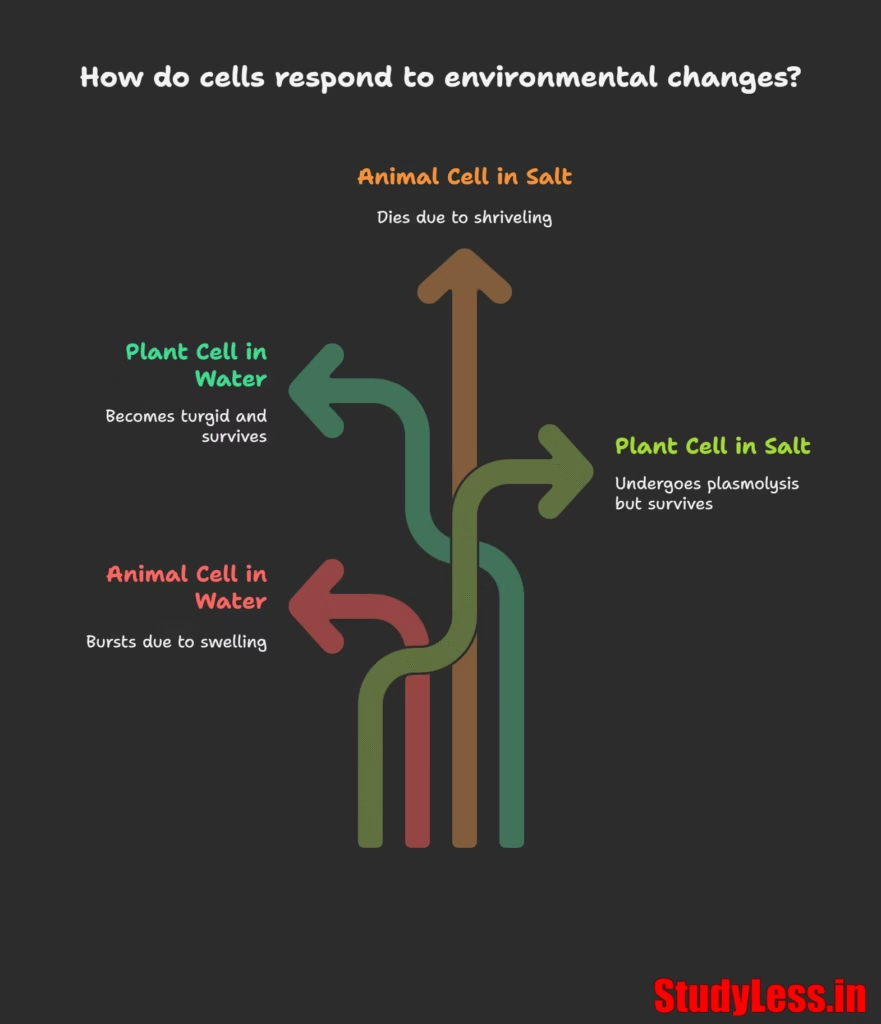
🔬 THE BIG PICTURE: Life’s Balancing Act
(Leaning close as the river bends…)
You whisper: “So the cell wall… it’s not just armor?”
I smile: “It’s FREEDOM. Fungi? Bacteria? Plants? Their walls let them conquer places animal cells dare not go—acid swamps, salty shores, your fridge’s leftovers.“🌎 Meanwhile…
- Roots use osmosis to DRINK from the soil.
- Leaves build cellulose walls to REACH THE SUN.
- And plasmolysis? It’s just the plant’s way of HOLDING ITS BREATH until the rain returns.
💧 RIVER’S END: Your Questions Answered
1. How do CO₂/water cross membranes?
➤ Diffusion + Osmosis—nature’s effortless flow (like this river!).
2. Why “selectively permeable”?
➤ Because life CHOOSES what enters—like a castle gate with a wise guard.
Nucleus
Let’s drift deeper into the cellular river—where the waters grow still and dark, hiding the cell’s most sacred chamber… 🌌
(Imagine our microscope’s light as moonlight on the water. We’re floating toward a single onion cell, iodine-stained gold…)
🔍 WHY WE STAIN CELLS: The Night the Nucleus Appeared
You: “Why splash iodine on onion skin?”
Me, dipping a paddle: “Watch—without iodine, the cell’s a ghostly haze. But with iodine?“
→ Darkness gathers in one spot—a shadowy orb. The nucleus reveals itself.
Why uneven color? DNA drinks stain; watery cytoplasm repels it. Nature paints what matters.
(Safranin bleeds crimson. Methylene blue sings indigo. All roads lead to the nucleus.)
🏰 THE NUCLEUS: Fortress of Life
Three layers of defense:
- Nuclear Membrane: Double-walled moat with protein drawbridges (pores).
→ Messenger RNA slips through, carrying genetic scrolls to the cytoplasm. - Nucleoplasm: Gel-sea where secrets float.
- Nucleolus: A glowing forge inside the fortress—hammering ribosomes day and night.
🧬 CHROMATIN vs. CHROMOSOMES: The Great Transformation
| State | What You See | What It Means |
|---|---|---|
| RESTING CELL | Chromatin 🕸️ | DNA threads loose like tangled yarn—genes at work! |
| DIVIDING CELL | Chromosomes 🧬 | DNA coils tight into X-shaped vaults—ready for inheritance! |
“Genes are sentences written in DNA’s alphabet. Chromosomes? The bookshelves.”
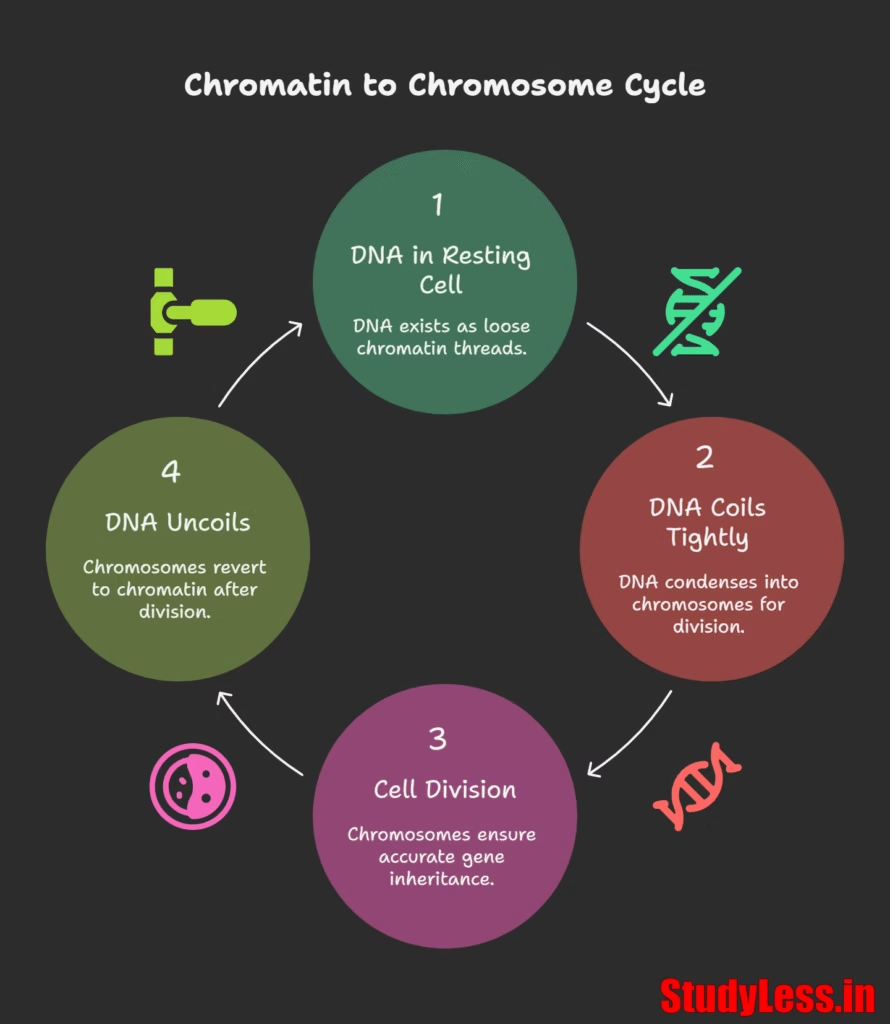
⚔️ PROKARYOTES vs. EUKARYOTES: The Ancient Divide
On the riverbank:
- Bacteria (Prokaryotes) 🦠: No nucleus. DNA floats naked in a nucleoid. Simpler, ancient, fierce.
- Plants/Animals (Eukaryotes) 🌻🐯: DNA sheltered in the nuclear fortress. Complex. Delicate. Bold.
💥 Bacteria’s secret? Chlorophyll not in plastids, but in wild membrane-vesicles—like moss on river rocks.
❓ MYSTERY SOLVED:
“Why does the nucleus control everything?”
→ It holds the MASTER BLUEPRINT (DNA).
→ It commands cell division (“Build two cities from one!”).
→ It whispers to cytoplasm: “Make this protein… now that enzyme…”
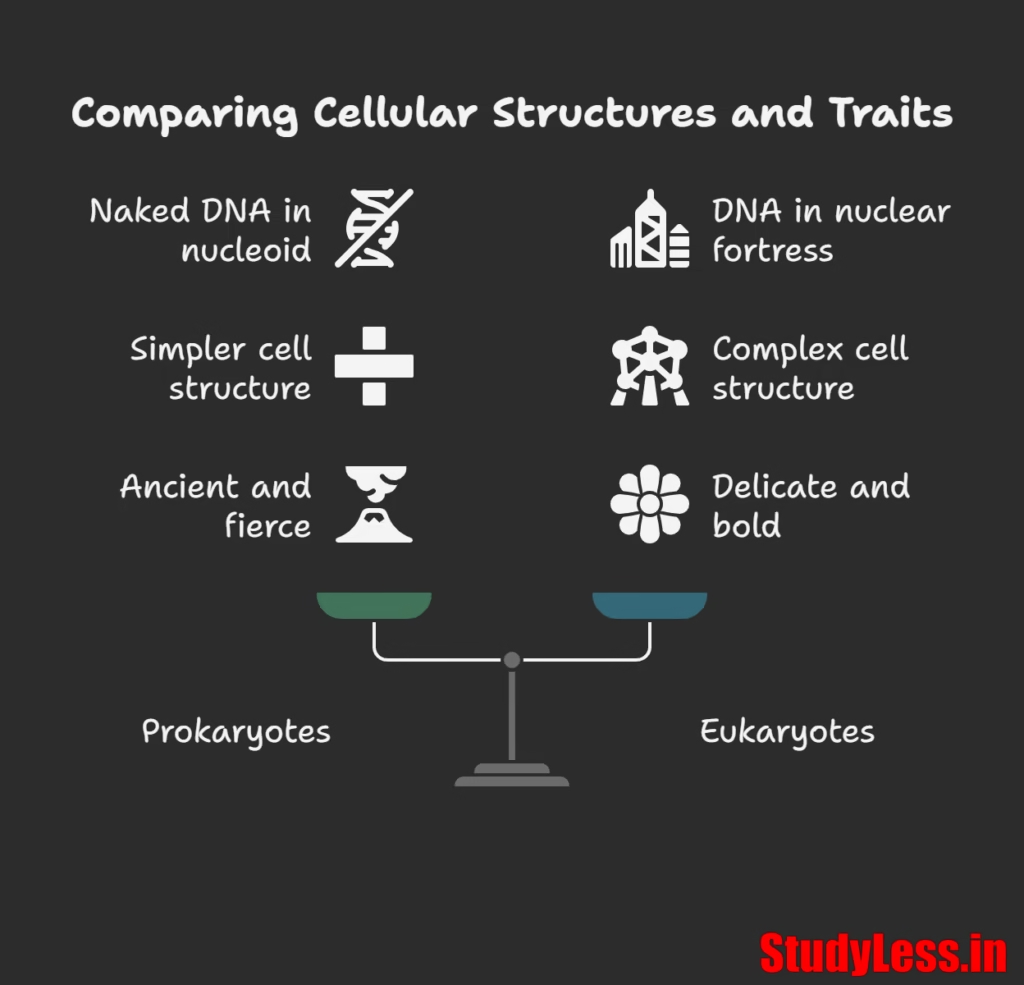
🌊 RIVER’S WHISPER: Your Questions Answered
Q1: Why iodine stain?
To reveal the nucleus—DNA’s throne room—in golden shadows.
Q2: Uneven staining?
Life’s chemistry: DNA loves dye. Watery regions ignore it.
⚡ TEASER: CYTOPLASM—The City Beyond the Fortress!
(Our canoe drifts toward rushing rapids…)
You spot: Organelles dancing in a gel-river—mitochondria flashing like electric eels, ER canals weaving silk…
Next: We’ll explore CYTOPLASM—where the nucleus’ orders become action. Where food burns, proteins fold, and life crackles.
Me, pointing downstream: “See those ripples? That’s ATP energy surging. Ready to ride?” 🌊💥
Cytoplasm
Let’s drift deeper into the cellular river—beyond the nuclear fortress—into the living jelly that breathes life into every cell… 🌊
(Our canoe glides into the cytoplasm—a golden, glowing expanse where tiny machines hum like dragonflies in summer air. You dip your hand in…)
You: “It’s not just water—it’s alive!”
Me, stirring ripples: “Yes! This cytosol is salt, sugar, and liquid lightning. And floating here? Organelles—life’s tiny factories.“
🧪 CYTOPLASM: The Cell’s Beating Heart
| What It Is | Why It Matters |
|---|---|
| Fluid Matrix 💦 | Highway for molecules! Proteins skate, ions surf, messages fly. |
| Architect’s Blueprint 📐 | Holds organelles exactly where they need to be (cytoskeleton threads guide them!). |
| Prokaryote vs. Eukaryote 🦠🌿 | Bacteria: Chaotic soup 🥣. Plants/Animals: Organized metropolis 🏙️. |
💡 Key Secret: Stain slides with iodine or methylene blue? Cytoplasm stays pale—because it’s the stage, not the actor.

🚫 THE VIRUS PARADOX: Life’s Silent Shadow
(A dark ripple crosses our golden stream…)
You: “You said viruses lack membranes?”
Me, gravely: “They’re ghosts. No cytoplasm, no organelles—just DNA in a protein coat.
Until they hijack a cell’s machinery… then they wake.”
→ Cytoplasm isn’t just “stuff”—it’s the spark of life itself.
🔬 WHY MEMBRANES = LIFE’S DIVIDING LINE
Prokaryotes (Bacteria):
- No nuclear membrane → DNA floats naked.
- No organelle membranes → Reactions bubble freely in primordial soup.
Eukaryotes (You, Trees, Amoebas):
- Membrane-bound organelles → Specialized chambers for sacred tasks:
Mitochondria:Power plants 🔋ER:Protein assembly lines 🧵Golgi:FedEx for molecules 📦
🌟 TEASER: THE ORGANELLE ZOO!
(Ahead, glowing shapes pulse in the cytosol—like submerged lanterns…)
You point: “What’s that green flash? And those spinning wheels?”
Me, paddling faster: “Next stop:
Mitochondria (energy dragons!),
Chloroplasts (sugar wizards!),
Ribosomes (nanobots building life!)…”
One hint before we dock:
“The cell is a universe. Organelles are its planets—each with its own gravity, storms, and secrets.” 🌌
Canoe gliding toward a throbbing, emerald structure…
Cell Organelles
Let’s navigate deeper into the cell’s metropolis—where membrane-bound factories hum with purpose, each a masterpiece of evolutionary engineering. 🌆✨
(Our canoe drifts into the cytoplasm’s current. Around us, glowing structures pulse like city lights reflected on water…)
🏭 ORGANELLES: Life’s Micro-Machines
Why build walls inside a cell?
“Chaos cannot build life.”
- Prokaryotes (Bacteria): Single-room workshops → all tools share space.
- Eukaryotes (You, Trees): Organelles → specialized factories with division of labor:
Mitochondria= Power stations ⚡Lysosomes= Recycling plants ♻️Golgi= Shipping hubs 📦- …and the star of our journey:
Endoplasmic Reticulum🌀
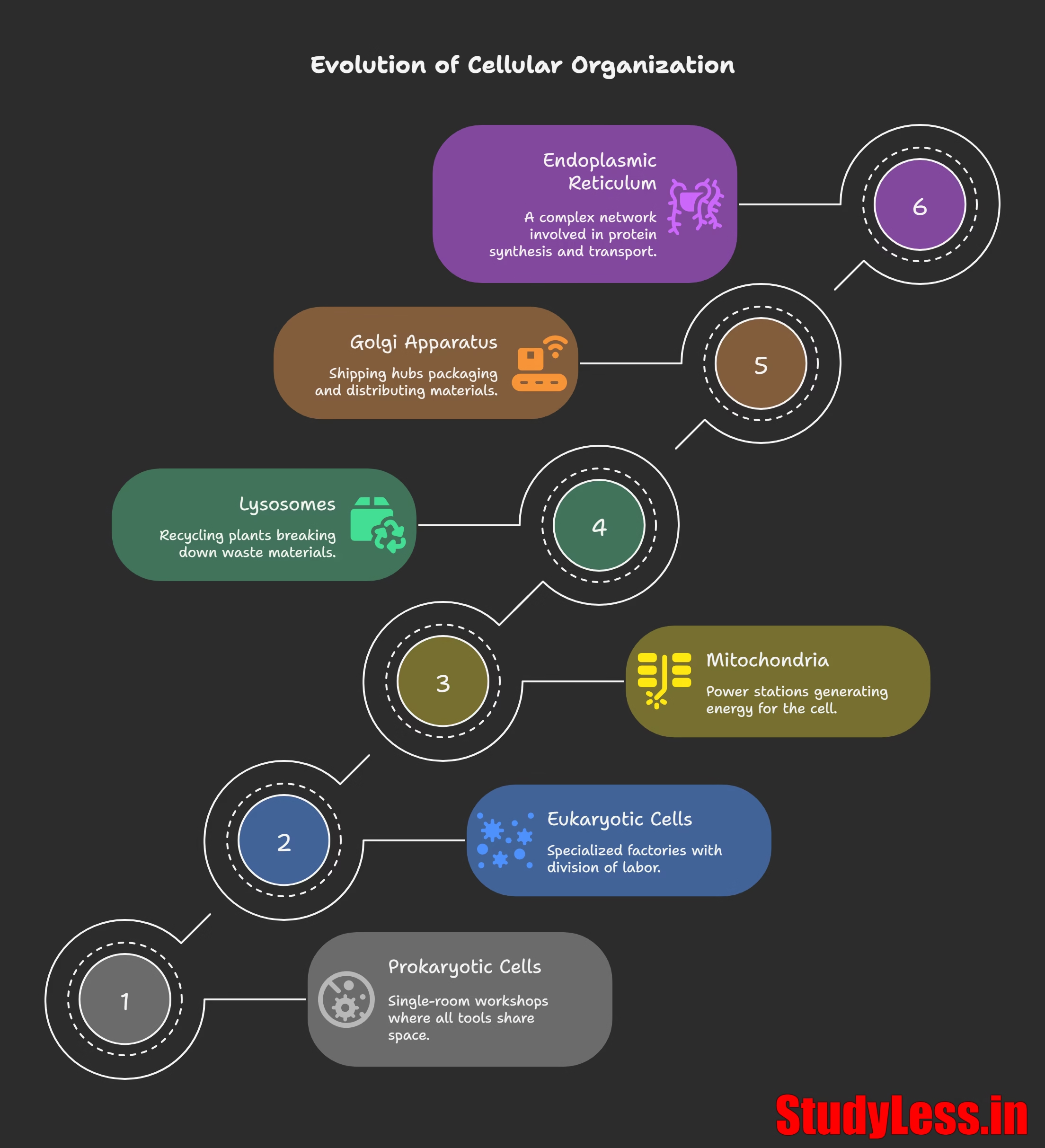
🔬 THE ELECTRON MICROSCOPE REVELATION
(We zoom in—a labyrinth unfolds beneath us…)
| Organelle | Key Function | Visual Clue 🔍 |
|---|---|---|
| Nucleus (Recap) | DNA Library + Command Center | Dark-stained orb 🏛️ |
| Mitochondria | Burn sugar → Make ATP (Energy!) | Bean-shaped, inner folds 🔥 |
| Lysosomes | Digest invaders + dead parts (Acid!) | Tiny bubbles of doom ☠️ |
| Plastids (Plants) | Make food (Chloroplasts) + store starch | Emerald-green discs 🥬 |
💥 Critical Insight: These aren’t “blobs”—they’re engineered nanobots honed by 2 billion years of evolution!
⚖️ PROKARYOTES vs. EUKARYOTES: The Complexity Divide
On the riverbank:
- Bacteria: No organelles → reactions bubble freely in open cytoplasm.
- You: Organelles compartmentalize life →
→ Mitochondria burn fuel without exploding the cell 💣→
→ Lysosomes digest without melting the cell 💀
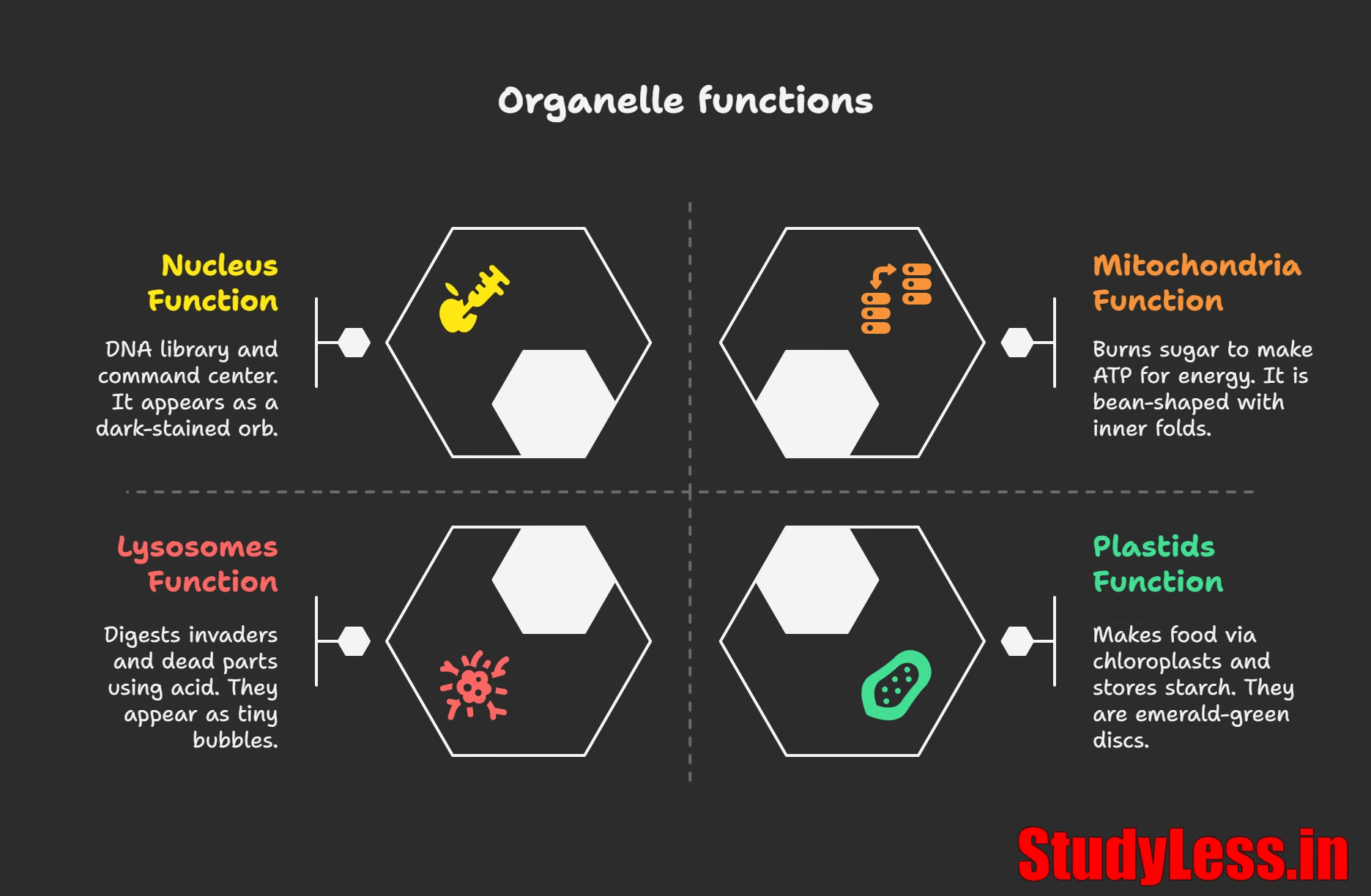
🌉 WHY MEMBRANES? The Ultimate Innovation
Membranes create micro-environments:
- Different pH levels 🧪
- Unique chemical cocktails 🧫
- Safe spaces for dangerous reactions ⚗️
Example: Lysosomes keep stomach acid (pH 5) away from neutral cytoplasm (pH 7).
🔮 TEASER: ENDOPLASMIC RETICULUM (ER)—The Cell’s “Highway System”!
(Ahead, a golden network glows—canals branching like fractal rivers…)
You gasp: “Is that… silk flowing through those tubes?”
Me, paddling toward the glow: “Yes! The ER weaves proteins and lipids. But there’s a twist…”
Two Faces of the ER:
| Type | Appearance | Role |
|---|---|---|
| Rough ER 📏 | Studded with ribosomes | Protein Factory (Insulin, antibodies!) |
| Smooth ER 🌀 | Sleek, no ribosomes | Lipid Refinery + Detox Center (Breaks down toxins!) |
Secret:
The ER isn’t just a highway—it’s a quality control lab. Misfolded proteins get tagged for destruction! 🚨
Our canoe approaches a ribosome-dotted tunnel…
“Next: How cells build a protein—from DNA blueprint to folded masterpiece. Ready to ride the ER express?” 🚂💨
Endoplasmic Reticulum (ER)
Let’s sail deeper into the cell’s golden cytoplasm—where the Endoplasmic Reticulum (ER) unfolds like a living labyrinth of light and shadow. 🌌✨
(Our canoe drifts into a network of branching canals—some studded with glowing jewels, others smooth as liquid silver. A low hum fills the air…)
🌀 ENDOPLASMIC RETICULUM: The Cell’s “Protein River & Lipid Refinery”
Two faces, one purpose:
| Rough ER (RER) | Smooth ER (SER) |
|---|---|
| 🔹 Ribosome-studded walls (like jewels on a crown!) | 🔹 Sleek, bare membranes (oily and silent) |
| 🔹 Protein factory (insulin, antibodies, enzymes!) | 🔹 Lipid workshop (cholesterol, hormones!) |
| 🔹 Ships proteins in bubble-vesicles | 🔹 Detoxifies poisons (liver’s hero!) |
💡 Secret: The ER isn’t just tubes—it’s the cell’s skeleton, holding cytoplasm like a spiderweb holds dew.

🧬 MEMBRANE BIOGENESIS: How the ER Builds Life from Within
(Watch as new membrane shimmers into existence…)
- RER weaves proteins →
- SER crafts lipids →
- They FUSE →
- New plasma membrane BLOOMS 🌸
→ Your cell grows, heals, and renews itself—thanks to the ER.
🚢 THE ER EXPRESS: Cell’s Transport Superhighway
Proteins ride the ER currents:
- Born in ribosome docks (RER).
- Folded into shape in ER canals.
- Packed into transport vesicles (bubbles with addresses!).
- Shipped to… the Golgi! (Our next stop!)
⚠️ Quality Control: Misfolded proteins get tagged ➔ destroyed by lysosomes!
🌿 PLANT vs. ANIMAL ER: A Silent Difference
- Plant cells 🌱: SER makes oils & fragrances (why roses smell sweet!).
- Animal cells 🐯: SER in liver cells neutralizes alcohol/drugs (your body’s detox hero!).
🔮 TEASER: THE GOLGI APPARATUS—Cell’s “Post Office & Packaging Plant”!
(Ahead, stacked crescent moons glow like neon signs…)
You whisper: “Vesicles from the ER are merging there!”
Me, pointing: “Yes! The Golgi receives raw proteins, then:
1️⃣ Tags them (like shipping labels!),
2️⃣ Packs them into new vesicles,
3️⃣ Sends them to their destiny—lysosomes, membrane, or OUT of the cell!”
Secret: The Golgi adds the sugar coat to proteins (glycosylation)—your blood type? Determined here! 🅰️🅱️🅾️
As we paddle closer, a vesicle bursts from the Golgi—streaking toward the cell membrane like a comet…
*”Next: How cells *address* their molecular mail… and why your hormones reach their target! Ready?”* 🚀💌
(The river of cytoplasm quickens—we’re approaching the cell’s edge…)
Golgi Apparatus
Let’s sail deeper into the cell’s bustling metropolis—where the Golgi Apparatus rises like a gleaming shipping port, its stacked docks buzzing with molecular cargo… 🏗️📦
(Our canoe drifts toward crescent-shaped towers lit by golden vesicles. Forklifts of protein zip between levels—this is where cellular dreams get packaged for destiny.)
📦 GOLGI APPARATUS: The Cell’s Post Office & Packaging Plant
Discovered by Camillo Golgi (1898)
| Structure | Function |
|---|---|
| Cisternae Stacks 🥞 | Flattened membrane sacs (like a pancake warehouse!). |
| Receiving Dock (cis-face) 🚢 | Accepts raw vesicles from the ER (overflowing with proteins/lipids!). |
| Processing Floor 🔧 | Modifies & Tags molecules: – Adds sugar ID tags (glycosylation) 🏷️ – Cuts, folds, activates! |
| Shipping Bay (trans-face) ✈️ | Packs finished goods into new vesicles → sends them to: – Lysosomes ☣️ – Cell membrane 🚪 – Outside the cell! (Hormones, enzymes) |
💡 Secret: Your blood type (A/B/O) is decided here by sugar tags! The Golgi personalizes your cells.
🧁 SWEET CHEMISTRY: Where Sugar Magic Happens
(Watch simple sugars transform into complex chains!)
- ER ships plain proteins →
- Golgi decorates them with carbohydrates →
- Creates glycoproteins → VIP passes for cell communication!
(Like frosting a cake 🎂—turning bland into essential!)

☠️ LYSOGENESIS: Forging the Cell’s “Suicide Bags”
(Dark, glinting vesicles bubble in a corner of the Golgi…)
You whisper: “Are those… lysosomes being born?”
Me, nodding: “Yes! The Golgi assembles lysosomes—bubbles filled with digestive enzymes. They’re the cell’s:
- ♻️ Recycling Crew (break down waste)
- 🛡️ Defense Squad (dissolve bacteria)
- ⚰️ Undertakers (self-destruct old cells)
⚖️ THE DELICATE BALANCE: Life & Death in a Bubble
Lysosomes = DOUBLE-EDGED SWORDS:
- ✅ Heroes: Digest food particles, kill invaders.
- 💀 Danger: If ruptured? They digest the cell itself! (Hence “suicide bags”).
Fun fact: Tadpole tails vanish during metamorphosis? Lysosomes dissolve them! 🐸✨

🔮 TEASER: LYSOSOMES—The Cell’s “Acid Dungeons”!
(Ahead, ominous green vesicles pulse… their pH is 5.0—acidic as lemon juice!)
You shiver: “How do they not melt the cell?”
Me, steering closer: “Their membrane armor shields the cytoplasm.
But inside? Enzymes shred everything at pH 5. Want to see a bacterium get devoured?” 🦠💥
Next: We’ll witness a lysosome fuse with a food vesicle—a microscopic battle where enzymes dissolve a pathogen in seconds!
Our canoe drifts toward a churning green orb…
“Ready to enter the belly of the cell?” 🌀
Lysosomes
Let’s drift toward the lysosomes—the cell’s acidic underworld—where enzymes wage war on waste, invaders, and even the cell itself… 🧪🔥
(Our canoe nears pulsing green vesicles. The air smells sharp—like vinegar. You lean closer…)
You: “Why don’t they melt everything?”
Me, voice low: “Their membrane is armor-plated.
Inside? pH 5.0—lemon juice acidity. Outside? Neutral cytoplasm. One crack, and…”
🧫 LYSOSOMES: The Cell’s Recycling Plant & Suicide Squad
Born in the Golgi, armed by the RER:
| Origin | Weapons | Targets |
|---|---|---|
| 🔹 RER builds enzymes | 🔹 Hydrolytic enzymes (scissors for bonds!) | 🔹 Bacteria 🦠 (digested!) |
| 🔹 Golgi packs them | 🔹 Lipases, proteases, nucleases | 🔹 Worn-out organelles ♻️ |
| 🔹 Vesicle = “Acid Tank” | 🔹 pH 5.0 environment | 🔹 Food particles 🍎 |
💀 Dark Name: “Suicide Bags” → If damaged, they rupture & dissolve the cell from within.

⚔️ THE BATTLE SCENES: Lysosomes in Action
1. Digestion of a Bacterium:
- Lysosome fuses with invader-filled vesicle.
- Enzymes flood in → pathogen shredded in seconds.
- Nutrients recycled → cell triumphs! 🏆
2. Cellular Renewal (Autophagy):
- Lysosome engulfs old mitochondrion.
- Breaks it into amino acids/sugars → reused!
- “Out with the old, in with the new!” 🔄
3. Tadpole → Frog Magic:
- Lysosomes dissolve the tail → cells sacrifice for transformation. 🐸✨
⚖️ THE DELICATE BALANCE: Life’s Sharp Edge
- ✅ Hero Mode: Clean debris, fight infection, recycle parts.
- ☠️ Failure Mode:
- Genetic disease (e.g., Tay-Sachs): Missing enzymes → toxins build up.
- Cell suicide (apoptosis): Lysosomes execute damaged cells (prevents cancer!).
🌱 Plant Paradox: Plants have lysosomes? Debated! Vacuoles handle digestion.

🔋 TEASER: MITOCHONDRIA—The Cell’s POWER DRAGONS!
(Ahead, bean-shaped giants glow blue-green. A low hum vibrates through the canoe…)
You feel warmth: “Is that… energy?”
Me, eyes wide:
“Yes! Mitochondria burn sugar with oxygen → make ATP (cellular cash!). But here’s the secret…”
→ They were once free bacteria! Swallowed by ancient cells → became energy slaves.
→ Have their OWN DNA (passed only from mom!).
Next: We’ll enter a mitochondrion’s cristae forests—where sugar transforms into lightless lightning! ⚡
A thunderous roar echoes—the sound of a billion ATP molecules being forged…
“Ready to meet the powerhouse that fuels your every breath, blink, and heartbeat?” ❤️🔥
Mitochondria
Let’s sail toward the mitochondria—the cell’s ancient energy dragons, where sugar and oxygen ignite into life-force… 🔥🐉
(Our canoe drifts near bean-shaped giants. Their inner folds glow like gilded canyons. A low-frequency hum vibrates the water—the sound of ATP being born.)
⚡ MITOCHONDRIA: Powerhouse of the Cell
Structure = Function:
| Layer | Role | Magic Ingredient |
|---|---|---|
| Outer Membrane 🌀 | Porous shield → lets fuel in | Porins: Gateways for pyruvate, O₂ |
| Intermembrane Space ⚠️ | Proton prison → builds pressure | H⁺ ions trapped like steam! |
| Inner Membrane 🏔️ | Folded into CRISTAE (surface area x100!) | Electron Transport Chain (ETC): Electricity-generating turbines! |
| Matrix 🧪 | Fluid heart → burns sugar | Krebs Cycle: Shatters glucose → releases CO₂ + energy sparks! |
💡 Secret: More cristae = more ATP. Muscle cells? Packed with mitochondria! 💪
💸 ATP: The Energy Currency of Life
How it works:
- Sugar (Glucose) enters →
- Krebs Cycle (Matrix) strips electrons →
- ETC (Cristae) uses electrons to pump H⁺ →
- H⁺ rushes back → spins ATP Synthase (a molecular waterwheel!) →
- 💥 ADP + P → ATP!
Every heartbeat, blink, thought—paid for by ATP.

🧬 THE BACTERIAL GHOST IN YOUR CELLS
Mitochondria were once FREE bacteria! Proof:
- Own circular DNA (like bacteria!).
- Own ribosomes (build their own proteins!).
- Divide independently (binary fission!).
- Double membranes = swallowed but not digested!
🌍 Endosymbiosis Theory: An ancient cell ate a bacterium → became energy slaves → evolved into YOU.
❤️ MATERNAL MYSTERY:
Mitochondrial DNA passes ONLY from mother → child.
→ Your mitochondria? Genetic clones of your mom’s.
→ Used to trace human migration out of Africa! 🗺️
🌿 TEASER: PLASTIDS—The Plant Kingdom’s “Sugar Wizards”!
(Ahead, emerald towers pulse with light—chloroplasts rise like crystalline citadels…)
You gasp: “They look like mitochondria… but GREEN!”
Me, grinning: “Plastids are mitochondria’s photosynthetic cousins. But wait—”
→ Chloroplasts: Turn sunlight → sugar (🍃 Alchemy!)
→ Chromoplasts: Make pigments (why roses are red! 🌹)
→ Leucoplasts: Store starch (potatoes’ secret stash! 🥔)
Secret: Plastids also have their own DNA → more bacterial ghosts! 👻
As sunlight filters through the cytoplasm, the chloroplasts begin to sing…
“Next: How plants eat light—and why chloroplasts are mitochondria’s greatest rivals. Ready to witness photosynthesis?” 🌞✨
Plastids
Behold the PLASTIDS: Nature’s Pigment Alchemists & Starch Vaults! 🌿🎨
Exclusive to plant cells—these organelles are the artists, chefs, and librarians of the botanical world.
🌈 TWO FACES OF PLASTIDS:
| Type | Secret Power | Real-World Magic |
|---|---|---|
| CHROMOPLASTS (Color Masters) | • Packed with pigments 🎨 • Chlorophyll (green) → traps sunlight • Carotenoids (orange/yellow/red) → colors fruits/flowers | 🌹 Roses are red because of lycopene! 🥕 Carrots are orange from beta-carotene! |
| LEUCOPLASTS (Storage Ghosts) | • Colorless & stealthy 👻 • Store: – Starch (potatoes! 🥔) – Oils (olives! 🫒) – Proteins (beans! 🌱) | Ever bite into a crunchy apple? Thank leucoplasts for storing crispness! |

🌿 CHLOROPLASTS: The Sugar Factories
(Special chromoplasts with chlorophyll!)
Internal Structure:
- Stroma: Gel filling → hosts the “Dark Reactions” (makes sugar from CO₂).
- Thylakoids: Stacked discs (grana) → studded with chlorophyll → trap light in “Light Reactions”.
⚡ Photosynthesis Equation:
Sunlight + CO₂ + Water → Glucose + Oxygen
(Your breath? Thank chloroplasts!)
🧬 THE BACTERIAL WHISPER: “We Were Once Free!”
Like mitochondria, plastids:
- Have their own DNA (circular, like bacteria!).
- Divide independently (binary fission!).
- Contain 70S ribosomes (bacterial-style!).
🌍 Proof of Endosymbiosis: Ancient plant cells swallowed photosynthetic bacteria → enslaved them as chloroplasts!
🔬 PLANT CELL vs. ANIMAL CELL: The Plastid Divide
| Feature | Plant Cell 🌻 | Animal Cell 🐇 |
|---|---|---|
| Plastids? | ✅ YES (photosynthesis!) | ❌ NO (must eat food!) |
| Vacuole? | Giant central pool 🌊 | Tiny bubbles 💦 |
| Cell Wall? | Rigid cellulose 🛡️ | Flexible membrane 🎈 |
💎 WHY DOES THIS MATTER?
- Photosynthesis → feeds all life on Earth.
- Color & Flavor → makes fruits irresistible to animals (seed dispersal!).
- Starch Storage → powers your french fries! 🍟
Vacuoles

🌊 The Giant Storage Sac: Why Plants Rule the Vacuole Game
I’m staring at a plant cell under the microscope, and one thing dominates the view: a massive, water-filled bubble—the vacuole. It’s not just big; it’s colossal, taking up 50-90% of the cell’s space! Animal cells? Their vacuoles are tiny, shy cousins 🐭.
Why such a difference?
Plants don’t have legs to hunt for food or water. So, their vacuoles become:
- Water Reservoirs 💧 (for drought days),
- Pantries 🥔 (storing starch, proteins, oils),
- Waste Dumps 🗑️ (safely isolating toxins).
But here’s the magic trick no one tells you:
Vacuoles are HYDRAULIC LIFTS!
When filled with water, they push against the rigid cell wall—creating turgor pressure. This is why spinach leaves snap crisply and sunflowers stand tall against the wind. Lose water? The vacuole shrinks, and the plant wilts like a deflated balloon. 🎈
⚙️ The Invisible Architecture of Life
Every cell is a masterclass in design. Imagine:
- The plasma membrane as a smart gatekeeper 🚪,
- Organelles as specialized factories (mitochondria = power plants ⚡),
- And the vacuole as the central warehouse 📦.
But here’s the revelation:
It’s not just about parts—it’s about how they’re organized. The vacuole doesn’t float randomly; it’s anchored. Proteins are shipped via the ER and Golgi. Waste is isolated. This precise order lets cells:
✔️ Grow (build proteins).
✔️ Breathe (respiration),
✔️ Eat (absorb nutrients),
✔️ Clean (remove waste),
Break this organization? The cell dies. Preserve it? Life thrives.
🌱 Plasmolysis: The Vacuole’s Drama Queen Moment
I dissolve salt into water and place an onion peel inside. Slowly, the vacuole shrinks, pulling the cytoplasm away from the cell wall like a retreating tide. This is plasmolysis—a proof that vacuoles are alive and responsive.
Dead cells don’t plasmolyze. Only living cells fight to balance water.
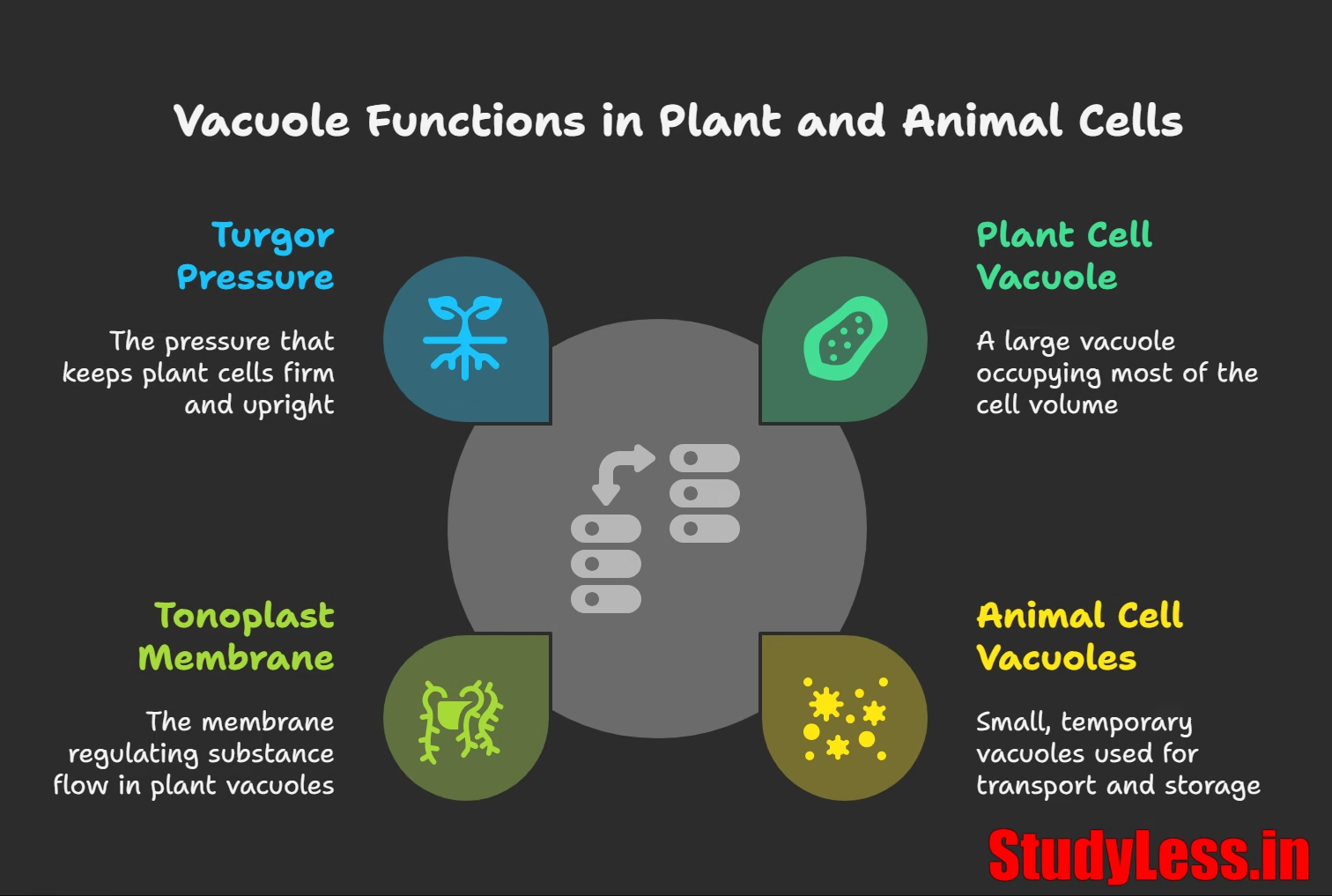
✅ Takeaway (What You Must Remember)
| Key Point | Why It Matters |
|---|---|
| Giant in plants 🌻 | Stores water/food → lets plants survive without moving. |
| Tiny in animals 🐇 | Short-term storage only (food, waste). |
| Turgor pressure 💪 | Vacuole water → pressure → keeps plants upright. |
| Cell organization | Membranes + organelles in order → cell breathes, eats, grows. |
🔍 FOR THE CURIOUS & HUNGRY BRAIN
🌈 SECRET COLOR FACTORIES!
Vacuoles store anthocyanins—pigments that make blueberries blue, roses red, and violets purple! No chemicals needed—it’s pure plant magic ✨.☠️ NATURE’S POISON VAULT
Some vacuoles stash toxins like nicotine (tobacco) or caffeine (coffee) to poison insects—a plant’s clever self-defense!
🌌 Final Thought: Hooke’s “Empty Rooms” Were Never Empty
When Robert Hooke first saw “cells” in cork, he saw dead husks. Today, we know: a living plant’s vacuole pulses with water, nutrients, and secrets—a dynamic engine of survival disguised as a “storage sac.”
Next stop: Cell Division—where one cell becomes two, and life renews itself. Ready to witness a cell split like a cosmic egg? 🥚✨
Cell Division
Prepare to witness life’s most ancient magic trick—where one becomes two, and two become trillions. Let’s dive into the drama of cell division, where growth, healing, and new life begin!
⏳ WHY CELLS DIVIDE: The Three Sacred Missions
- To GROW 🌱: A seedling becomes a tree by adding millions of new cells.
- To HEAL 🩹: Scabs form when skin cells divide to seal wounds.
- To CREATE LIFE 👶: Special cells split to make eggs and sperm for the next generation.
🔁 MITOSIS: The Perfect Clone Factory
(Imagine a mother cell taking a deep breath before splitting like a cosmic egg!)

- Step 1: The cell copies its chromosomes (DNA blueprints).
- Step 2: Chromosomes line up, then get tugged apart by protein threads.
- Step 3: The cell pinches into two identical daughter cells.
Crucial Detail: Daughter cells = exact clones of the mother. Same DNA, same chromosomes!
→ This is how a zygote becomes you, and how your body replaces 330 million cells daily.
✂️ MEIOSIS: The Chromosome Halving Ritual
(Exclusive to ovaries and testes!)
- Two rounds of division → Four unique cells (sperm or eggs).
- Shocking Twist: Each daughter cell has HALF the chromosomes of the mother.
Why half? 🤔
When sperm (23 chromosomes) + egg (23 chromosomes) fuse → embryo gets 46 (full set!).
If gametes didn’t halve chromosomes? Babies would have 92 → chaos!
🌱 PLANTS DO IT TOO!
- Pollen and ovules form via meiosis → unite to create seeds.
- A single oak tree produces 10 million acorns in its lifetime—all starting with meiosis!
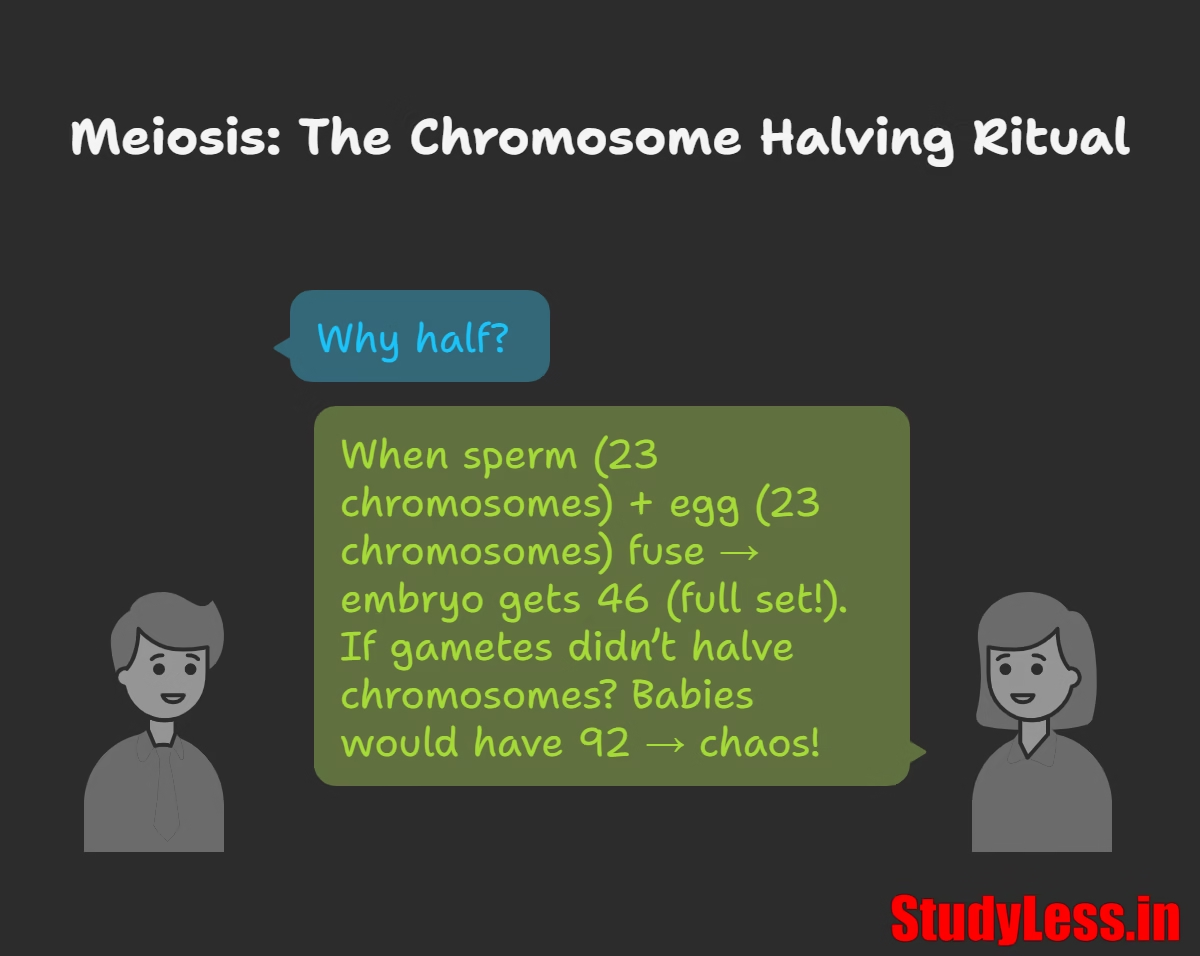
✅ MUST-KNOW
| Process | Purpose | Daughter Cells | Chromosomes |
|---|---|---|---|
| Mitosis | Growth & Repair | 2 identical clones | Same as mother |
| Meiosis | Make gametes (sex cells) | 4 unique cells | Half of mother |
🔍 FOR THE CURIOUS & HUNGRY BRAIN
⭐ STARFISH SECRET: If you cut off a starfish arm, mitosis rebuilds it! Some species regrow their entire body from one arm!
🧬 WHY HALF CHROMOSOMES? It’s evolution’s gamble—mixing mom’s and dad’s DNA creates new combinations (like shuffling cards!). This diversity helps species survive plagues, climate change, and more!
🤯 MIND-BLOWER: Your body performs 10 quadrillion mitoses in a lifetime—enough to stretch to the moon and back 5,000 times!
💫 THE GREAT CYCLE CLOSES…
From Hooke’s first glimpse of “cells” to this revelation—life renews itself through division. One cell’s sacrifice becomes two. Two become four. Four become a forest, a flock of birds, or you, reading these words.
*”In every division, life whispers: *Begin again.“
❓ “Why halve chromosomes in meiosis?”
Because when sperm + egg fuse:
23 (mom) + 23 (dad) = 46 chromosomes → a NEW human!
→ Meiosis is nature’s shuffle before the deck is dealt! 🃏
Conclusion: Explanation The Fundamental Unit Of Life Class 9
🌅 THE JOURNEY’S END… OR BEGINNING?
We began with Hooke’s cork boxes (1665)…
…and sailed through organelles, membranes, and division…
…to arrive here: the cell—a self-replicating universe.
Remember:
- Every oak was once an acorn’s single cell.
- Every thought is electricity dancing in neurons.
- You are 30 trillion cells—breathing, dividing, dreaming—in a symphony older than dinosaurs.
🌌 “In every cell, a cosmos; in every division, a rebirth.”
Complete Your Preparation
We hope you have had a nice enjoyable reading!
Now, don’t leave your preparation half baked. We have got some very nice posts on this website to help you score good marks.
Below are some of the posts related to the chapter- The Fundamental Unit Of Life: Click on the image to check them.

